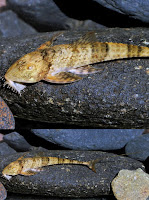[Most Recent Entries] [Calendar View]
Thursday, November 22nd, 2018
| Time | Event | ||||
| 4:06a | [Botany • 2018] Utricularia biceps (Lentibulariaceae) • A New Carnivorous Species Endemic to the Campos Rupestres of Brazil
Abstract Utricularia biceps (Lentibulariaceae), a new species belonging to U. sect. Foliosa, is here described and illustrated. This new species is endemic to the campos rupestres of eastern Brazil, an extremely biodiverse and endangered vegetation. Notes on phenology, ecology, habitat, and conservation are provided, along with a discussion on the features that distinguish this species from the other taxa of the genus. The recent discovery of this and many other new species in the Botumirim region, in northern Minas Gerais, highlight this area as a priority for biodiversity conservation and emphasize the importance of extensive studies on the flora of the region. Keywords: carnivorous plants, conservation, Lamiales, taxonomy, Eudicots Paulo Minatel Gonella and Paulo César Baleeiro. 2018. Utricularia biceps (Lentibulariaceae), A New Carnivorous Species Endemic to the Campos Rupestres of Brazil. Phytotaxa. 376(5); 214–222. DOI: 10.11646/phytotaxa.376.5.4 facebook.com/PauloGonella/posts/2075287439196911 | ||||
| 2:45p | [Ichthyology • 2018] Spatuloricaria terracanticum • A New Species of Spatuloricaria Schultz, 1944 (Siluriformes: Loricariidae), from the Orinoco River Basin, Colombia
A new species of Spatuloricaria is described from the Orinoco River basin, Colombia. The new species can be distinguished from its congeners by the following characters: a broad, dark brown stripe on the first pre-dorsal plate, which occupies the entire plate, reaching the preopercle, and sometimes reaching the second pre-dorsal plate; the possession of a small group of plates posterior to the urogenital pore; the abdominal surface with scattered, very small plates leaving naked areas; the possession of five transverse dark brown bands on the dorsal region; and four to five premaxillary teeth. The new species is the first valid species of Spatuloricaria distributed in the Orinoco River basin. Ecological notes of the species and comments regarding the taxonomy and phylogenetic relationships of the genus are offered.
Spatuloricaria terracanticum, new species Spatuloricaria sp.—Urbano-Bonilla et al., 2018:74 [listed; included in identification key for Loricariidae genera and species of the Cusiana River, Orinoco River basin]. Etymology.—The specific epithet is from the latin terra [earth] and canticum [song]. It is dedicated to the Llanos work songs (cantos de vaquería). Its origin dates back to the 16th century and has been transferred from generation to generation in the Llanos region of Colombia and Venezuela. Sung a cappella, melodies reflect the feeling and the close relationship of the llanero with their myths, beliefs, nature, climate, and animals. Although these songs have been gradually lost within modern society due to economic, political, and social causes, UNESCO has declared them as intangible cultural heritage of humanity Alejandro Londoño-Burbano, Alexander Urbano-Bonilla, Yecid Rojas-Molina, Hernando Ramírez-Gil, and Saúl Prada-Pedreros. 2018. A New Species of Spatuloricaria Schultz, 1944 (Siluriformes: Loricariidae), from the Orinoco River Basin, Colombia. Copeia. 106(4); 611-621. DOI: 10.1643/CI-18-087 Una nueva especie de Spatuloricaria, proveniente del río Orinoco, Colombia, es descrita. La nueva especie se distingue de sus congéneres por los siguientes caracteres: una banda transversal ancha en la primera placa predorsal, la cual ocupa toda la placa y el preopérculo, alcanzado algunas veces la segunda placa predorsal; un grupo de pequeñas placas posterior al poro urogenital; abdomen cubierto por placas pequeñas y dispersas, las cuales dejan áreas desnudas; presencia de cinco bandas transversales marrón oscuro en la región dorsal; y cuatro a cinco dientes en el premaxilar. La nueva especie es la primera especie válida de Spatuloricaria distribuida en la cuenca del río Orinoco. Se presentan notas ecológicas de la especie, y comentarios con relación a la taxonomía y relaciones filogenéticas del género. |
| << Previous Day |
2018/11/22 [Calendar] |
Next Day >> |









